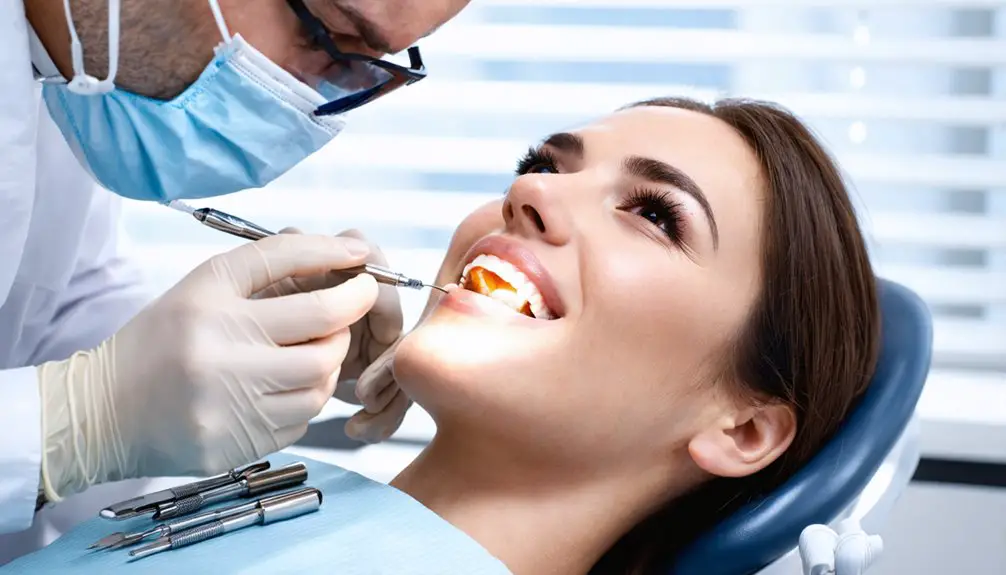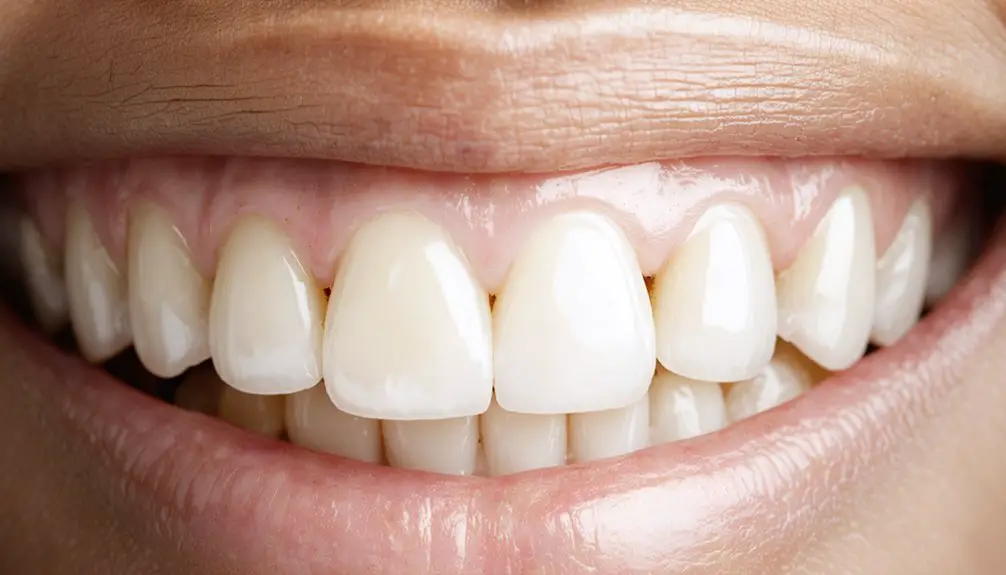Professional in-office teeth whitening delivers dramatic results in a single 60-90 minute visit. Your dentist will assess your teeth’s condition, apply protective barriers, and use high-concentration peroxide gels activated by specialized light technology. The oxidation process breaks down stains within your tooth enamel, producing immediate whitening effects that can last 6 months to 3 years. Understanding the complete procedure guarantees you’ll maximize your investment in a brighter smile.
Key Takeaways
- Professional teeth whitening uses hydrogen peroxide or carbamide peroxide gels activated by LED, UV, or laser light for immediate results.
- Pre-treatment includes shade assessment, professional cleaning, and protective barriers to ensure safe and effective whitening.
- Treatment sessions typically last 60-90 minutes with gel application and light activation in 15-minute intervals.
- Results are visible immediately after treatment, with teeth becoming 3-8 shades lighter in a single session.
- Avoid dark-colored foods and beverages for 48 hours post-treatment while following dentist-recommended maintenance instructions.
Understanding the Science Behind Professional Teeth Whitening
While many people think of teeth whitening as a simple cosmetic procedure, the science behind professional in-office treatments involves complex chemical reactions and precise molecular interactions.
When you undergo professional whitening, hydrogen peroxide or carbamide peroxide penetrates your tooth’s enamel, reaching the dentin layer where most stains reside. pH balancing agents help protect enamel during this process by neutralizing acidic effects.
The oxidation process begins as these agents break down into highly reactive oxygen molecules. These molecules target and dismantle chromophores – the compounds responsible for tooth discoloration.
Through chemical interactions, the peroxide agents convert large, pigmented molecules into smaller, colorless particles that diffuse out of your tooth structure.
Light activation from LED, UV, or laser sources accelerates this process by enhancing peroxide decomposition, delivering faster and more effective results for your patients.
Professional teeth whitening is increasingly popular, with approximately one-fifth of Americans having undergone the procedure.
Pre-Treatment Assessment and Preparation Steps
Before starting your professional teeth whitening treatment, you’ll need a precise shade assessment using standardized guides to document your initial tooth color and establish clear benchmarks for success.
Your teeth should undergo thorough professional cleaning to remove surface stains, plaque, and tartar that could impair the whitening gel’s effectiveness. Applying lip moisturizer before the procedure helps prevent discomfort during the extended treatment time.
A consultation with your dentist will determine if you’re a good candidate for in-office whitening treatment, taking into account your dental history and whitening goals.
Protection of your soft tissues with barriers and retractors is essential to prevent chemical irritation while ensuring ideal contact between the whitening agent and tooth surfaces.
Shade Selection and Documentation
Every successful teeth whitening treatment begins with precise shade selection and thorough documentation procedures.
You’ll need to conduct shade matching in natural lighting conditions using a standardized shade guide like Vita Classical or Vita 3D-Master. Document the initial shade with photographs and detailed chart notes, ensuring teeth are slightly damp for accurate assessment.
Patient education is essential during this phase. Explain how existing restorations and intrinsic stains may affect results, and advise them to avoid staining agents before treatment. To optimize results, recommend avoiding staining foods and drinks at least 48 hours prior to the session. Managing patient expectations is crucial, as most can expect a typical two-shade change with treatment.
Schedule professional cleaning beforehand to establish an accurate baseline. You’ll want to capture multiple reference points, focusing on the middle third of the crown for consistency. Use digital tools when available to analyze and maintain consistent records throughout the whitening process.
Thorough Dental Cleaning
Professional dental cleaning represents the cornerstone of successful in-office teeth whitening preparation. Your dental hygienist will perform thorough plaque removal and tartar elimination to guarantee peak whitening agent penetration. This meticulous cleaning prevents uneven results and creates the ideal surface for treatment.
During your cleaning appointment, you’ll receive professional scaling and polishing to remove stubborn deposits and surface stains. Your hygienist will focus on achieving a pristine oral environment, essential for uniform whitening results. They’ll evaluate your current dental hygiene practices and may recommend adjustments to your routine. Using toothpaste for sensitivity beforehand can help reduce potential discomfort during the whitening process. Your dentist will use a shade guide assessment to document your starting tooth color.
Before scheduling your whitening session, you’ll need to maintain strict oral care protocols, including twice-daily brushing, daily flossing, and using antibacterial mouthwash.
These preparatory steps maximize treatment effectiveness and help secure predictable, lasting results.
Tissue Protection Measures
Proper tissue protection during teeth whitening requires a detailed pre-treatment assessment to safeguard your oral health.
You’ll need a thorough dental evaluation to identify any sensitivity, enamel wear, or gum inflammation that could increase tissue irritation. Patients with periodontal disease must resolve this condition before pursuing whitening treatment. Using desensitizing toothpaste one week before treatment helps minimize nerve sensitivity and discomfort. We’ll review your medical history and assess existing restorations to determine treatment suitability.
To maximize barrier effectiveness, you’ll receive protective measures including light-cured resin barriers or protective gels to shield your soft tissues from whitening agents.
We’ll precisely isolate your gums using rubber dams and cotton rolls to prevent contact with peroxide compounds.
Before treatment, you’ll need professional cleaning and must follow specific oral hygiene protocols, including brushing with non-abrasive toothpaste and avoiding staining substances.
Remove any oral jewelry to guarantee proper barrier placement and protection.
Safety Measures and Patient Protection
To guarantee maximum safety during in-office teeth whitening, dental professionals implement an extensive set of protective measures and protocols.
You’ll undergo a thorough initial examination to assess your oral health and identify any contraindications. The safety protocols include using ADA-approved products with regulated concentrations and protecting your soft tissues with barrier gels or rubber dams.
Your treatment plan will be customized to your specific needs, with careful monitoring throughout the process.
Patient education guarantees you’re aware of potential sensitivity and know how to respond to any adverse reactions. You’ll receive clear instructions on proper usage and maintenance, including the importance of using soft-bristled toothbrushes and regular flossing during treatment.
If you experience any discomfort, your dentist will adjust the treatment immediately.
Types of Professional Whitening Agents

With proven safety protocols in place, understanding the distinct whitening agents used in professional treatments becomes the next key consideration.
Professional teeth whitening relies primarily on two powerful compounds: hydrogen peroxide and carbamide peroxide, both delivered at considerably higher concentrations than over-the-counter products.
These professional whitening agents work through:
- Direct application of high-concentration hydrogen peroxide (25-40%) for rapid results during chairside treatments
- Custom-fitted trays containing sustained-release carbamide peroxide for controlled exposure
- Advanced formulations that penetrate deep into tooth enamel to eliminate both surface and intrinsic stains
- Specialized delivery systems that activate these compounds using laser technology or specialized lights
These professional-grade formulations achieve dramatic results, often improving tooth color by up to eight shades in a single visit while maintaining ideal safety under clinical supervision.
The Step-by-Step Whitening Procedure
Professional in-office teeth whitening follows a precise, multi-phase protocol designed to maximize results while guaranteeing patient safety. Contrary to whitening myths, the process begins with thorough preparation, including baseline shade measurement and professional cleaning.
You’ll address patient concerns by carefully applying protective barriers to shield soft tissues before proceeding. The procedure continues with precise application of hydrogen peroxide or carbamide peroxide gel to exposed tooth surfaces.
You’ll activate the whitening agent using specialized light or laser technology, typically conducting 3-4 rounds of 15-minute intervals. Throughout treatment, maintain protective barriers and monitor patient comfort.
Complete the session by removing gel, applying desensitizing agents, and documenting shade improvement. Provide detailed aftercare instructions to guarantee lasting results, which typically extend up to one year with proper maintenance.
Light and Laser Activation Methods
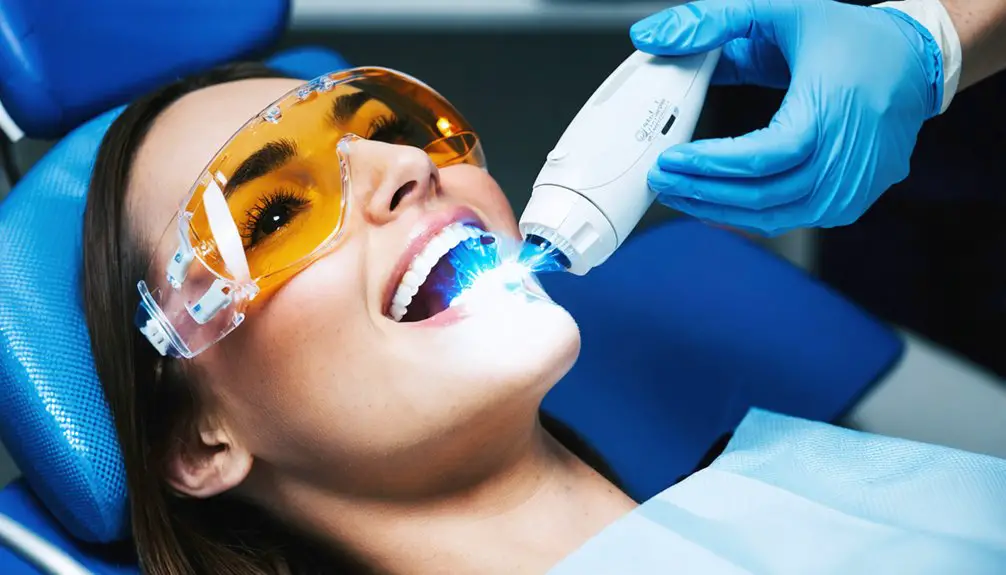
Light-activated teeth whitening employs either LED, UV, or laser technology to accelerate the breakdown of peroxide-based bleaching agents applied to your teeth.
You’ll experience the most effective results from blue LED light (460-480 nm wavelength) or diode laser treatments, which trigger photochemical reactions while minimizing heat-related sensitivity.
During your treatment, the light or laser energy will enhance the oxidation process of the whitening gel through controlled exposure times of 10-30 minutes, breaking down stain molecules more efficiently than gel alone.
Light Activation Technologies Used
Modern dental practices employ various light activation technologies to accelerate the teeth whitening process, including LED systems, halogen lamps, lasers, UV light, and plasma arc devices.
These technologies enhance the breakdown of peroxide-based whitening gels through controlled light activation, maximizing your treatment outcomes.
For maximum LED effectiveness and light safety during your whitening procedure, you’ll encounter these key technologies:
- Blue LED systems, offering superior safety profiles compared to UV alternatives while effectively activating whitening agents
- Diode lasers, providing precise activation through specific wavelength targeting
- Halogen lamps, delivering broad-spectrum light activation with established clinical results
- Plasma arc devices, generating intense light energy for accelerated whitening effects
The selection of light technology directly impacts your treatment’s speed and comfort, with LED systems showing the most favorable balance of effectiveness and safety.
Laser Treatment Process Steps
Before undergoing laser teeth whitening, you’ll proceed through a methodical sequence of preparation steps to secure ideal results and safety.
First, you’ll receive a thorough dental exam and professional cleaning to optimize whitening effectiveness. Your practitioner will apply protective barriers and eyewear before carefully drying your teeth and applying specialized peroxide gel.
During the laser treatment, your provider will position the handpiece precisely 1mm from your tooth surface, delivering controlled energy cycles of approximately 30 seconds per quadrant.
They’ll typically administer two doses per area for enhanced results. After completing the laser cycles, they’ll allow the gel to continue working for five minutes before removal.
The process concludes with thorough rinsing and application of desensitizing agents to protect your enamel and secure your comfort.
Heat Energy Benefits Explained
When applied in professional teeth whitening, heat energy serves as a critical catalyst that accelerates the breakdown of hydrogen peroxide into reactive oxygen radicals.
Through controlled heat activation, you’ll achieve enhanced whitening efficiency while maintaining patient safety and comfort.
Here’s how heat energy enhances the whitening process:
- Triggers faster peroxide decomposition, increasing the concentration of stain-breaking oxygen species
- Enables precise temperature control when using LED or laser systems, keeping pulp temperature rises below critical 5.5°C threshold
- Reduces overall treatment time to about one hour with laser-activated systems
- Creates more consistent results with fewer required sessions compared to traditional methods
Modern light-activated systems harness heat’s benefits while incorporating protective barriers to minimize soft tissue exposure and guarantee optimal results for your patients.
Managing Post-Treatment Care and Sensitivity
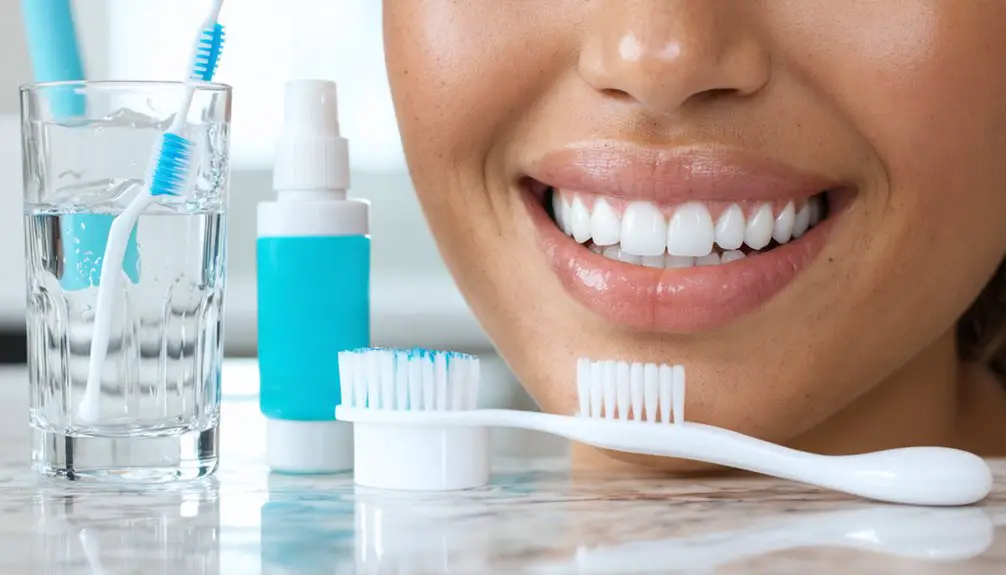
Successful teeth whitening treatment requires diligent post-procedure care to maximize results and minimize discomfort. Following essential post-treatment guidelines, you’ll need to avoid staining substances like coffee, tea, and red wine for at least 48 hours.
Stick to white or light-colored foods, and maintain hydration primarily with water and milk.
For sensitivity management, you’ll likely experience discomfort for 48-72 hours post-treatment. Use desensitizing toothpaste and take over-the-counter pain relievers as needed.
Avoid temperature extremes in foods and beverages. Continue your oral hygiene routine, but brush gently as your enamel’s protective layer regenerates.
Don’t use chlorhexidine mouthwash for 48 hours, as it can compromise your results. If you’re using supplemental at-home whitening trays, follow your dentist’s specific instructions for ideal maintenance.
Expected Results and Treatment Duration
You’ll typically notice significant whitening results from in-office treatments within a single 30-60 minute session, with most patients achieving 7-8 shades of improvement using professional systems like Zoom® Whitening.
Your treatment’s duration will depend on the concentration of hydrogen peroxide used, with higher concentrations (35-40%) requiring shorter application times while still delivering effective results.
The immediate effects you’ll see from in-office whitening are more dramatic than over-the-counter options, though you should expect some variation in individual outcomes based on your starting tooth shade and enamel composition.
Results Timeline Expectations
Professional in-office teeth whitening delivers dramatic results within a single 60-90 minute session, brightening teeth by up to eight shades.
You’ll experience maximum brightness during the first six months, with results longevity extending 1-3 years depending on your lifestyle habits and oral care routine.
For ideal long-term results, follow these key timeline expectations:
- Initial whitening effects appear immediately after your 60-90 minute treatment
- Peak brightness maintains through the first 6 months post-procedure
- Gradual fading may occur between 6-12 months, though teeth remain noticeably whiter
- Touch-up recommendations typically begin after one year, with maintenance treatments scheduled at least 6 months apart
Your results’ duration largely depends on avoiding staining agents and maintaining excellent oral hygiene practices.
Treatment Session Length Explained
Understanding the specific duration of in-office teeth whitening helps set accurate expectations for your treatment plan.
You’ll typically spend 30-60 minutes per session, though treatment variations can extend to two hours for severe staining cases.
Your dentist will apply high-concentration hydrogen peroxide (25-40%) and may use light activation to accelerate the whitening process.
Session frequency depends on your desired results and stain severity – you might need multiple appointments to achieve the best whitening of 3-8 shades lighter.
For moderate discoloration, shorter sessions with 35% peroxide can be as effective as longer treatments with higher concentrations.
If you have sensitive teeth or specific types of staining, your dentist will adjust the session length and concentration accordingly to guarantee safe, effective results.
Maintaining Your Bright Smile at Home
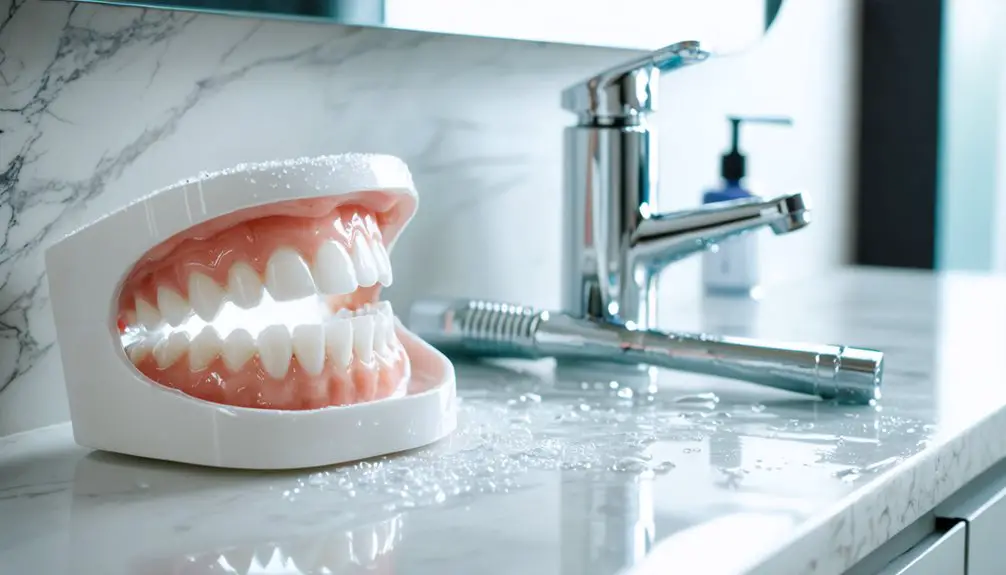
After investing in professional teeth whitening, maintaining those brilliant results requires consistent at-home care and lifestyle modifications.
Despite common whitening myths, preserving your results doesn’t compromise enamel health when you follow proper protocols.
Modern teeth whitening methods, when done correctly, maintain both bright smiles and strong enamel – making lasting results achievable with proper care.
- Brush twice daily with fluoride toothpaste and a soft-bristled brush, replacing it every 3 months to protect your enamel while removing surface stains.
- Minimize exposure to staining agents by drinking beverages through a straw and limiting coffee, tea, and red wine consumption.
- Use dentist-recommended whitening maintenance products, including peroxide-based rinses and custom trays for periodic touch-ups.
- Schedule regular professional cleanings and incorporate protective measures like waiting 48 hours post-treatment before brushing and chewing sugar-free gum to stimulate natural cleansing saliva flow.
Cost Breakdown and Insurance Coverage
While investing in a brighter smile can transform your appearance, in-office teeth whitening costs vary considerably based on multiple factors.
You’ll typically find professional treatments ranging from $300 to $1,000 per session, with popular options like Zoom! averaging $500 to $600. Laser whitening can reach up to $1,368, depending on your provider and location.
Several cost factors influence your final investment, including your dentist’s expertise, geographic location, and specific treatment requirements.
Since teeth whitening is considered cosmetic, insurance options are limited, with most dental plans not covering the procedure. However, you can explore dental discount programs or financing alternatives like CareCredit to manage expenses.
When evaluating your options, consider that professional treatments deliver faster, more dramatic results lasting 6 months to 3 years.
Frequently Asked Questions
Can I Get Teeth Whitening While Pregnant or Breastfeeding?
You shouldn’t get teeth whitening while pregnant or breastfeeding due to safety concerns. Wait until after these periods, and consult your dentist for specific guidance about pregnancy considerations and alternative options.
How Soon After Dental Work Can I Undergo Professional Teeth Whitening?
Like Rome wasn’t built in a day, your dental work needs time to settle. You’ll need to wait 7-14 days, depending on restoration type, to avoid teeth sensitivity. Schedule a dental consultation for personalized timing.
Will Teeth Whitening Affect My Existing Crowns or Veneers?
You can’t whiten crowns or veneers with bleaching agents since they’re made of non-porous materials. Crown discoloration and veneer maintenance require professional cleaning or replacement to match newly whitened natural teeth.
Is Teeth Whitening Safe for People With Metal Braces?
You shouldn’t whiten teeth while wearing metal braces, as it causes uneven results and may damage brackets. Focus on proper braces maintenance and use gentle whitening alternatives like specialized toothpaste until treatment ends.
Can Medications Affect the Success of Teeth Whitening Treatment?
Yes, medication interactions can greatly impact whitening success. You’ll need to inform your dentist about medications you’re taking, as they may cause intrinsic staining or increased dental sensitivity during treatment.
References
- https://www.suttonpda.com/in-office-teeth-whitening/
- https://www.healthline.com/health/dental-and-oral-health/laser-teeth-whitening
- https://alamoanadentalcare.com/your-step-by-step-guide-to-teeth-whitening-at-the-dentist/
- https://coulonwatts.com/2020/07/08/how-does-teeth-whitening-work-at-a-dentist-office/
- https://www.yourdentistryguide.com/professional-whitening/
- https://progrin.com/blog/the-science-and-art-of-professional-teeth-whitening/
- https://sandlakedental.com/blog/understanding-the-science-behind-teeth-whitening/
- https://verodentalspa.com/blog/the-science-of-tooth-whitening/
- https://www.champaigndentalgroup.org/about-us/blog-articles/how-teeth-whitening-works-the-science-behind-brighter-smiles
- https://www.toothcafeky.com/post/how-does-professional-teeth-whitening-work
